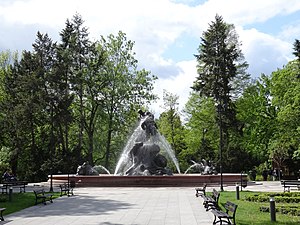Flood Well (Bydgoszcz)
The Flood Fountain in the Polish city of Bydgoszcz is an imposing, multi-figure fountain with a water feature, it is located in Casimir the Great Park . The facility was inaugurated in 1904 and was destroyed in 1943; the re-inauguration took place in 2014.
Planning and construction
In mid-September 1897, the Prussian State Art Commission for the Promotion of Fine Arts suggested the production of a monumental fountain and its installation in a larger provincial town; the costs of the design and the execution in the amount of 60,000 to 75,000 marks were to be paid from the state fund for works of art, the costs for installation, setting up the well system, water supply, space regulation, etc., which were estimated at 20,000 to 25,000 marks, on the other hand from the city concerned. The city of Bromberg was considered for this fountain.
As early as April 25, 1898, the Prussian minister of education had issued the competition to obtain a model for the fountain. All Prussian and German sculptors living in Prussia were admitted to the competition; a motif was not prescribed, but only said that the fountain should be developed free-standing and that the sculptures should be made of bronze. 44 drafts were received, which were examined on December 5th and 6th, 1898 by the members of the State Art Commission and two representatives of the city of Bromberg.
The first prize was unanimously awarded to the design by the Berlin sculptor Ferdinand Lepcke with the deluge as a motif, and this was designated for execution. Six years passed until the artistic execution of the extensive work, the bronze casting, which was transferred to the Noack & Gladenbeck fine art foundry in Friedrichshagen near Berlin, the various stonemason, masonry and foundation work were completed. Before the installation at the destination, the middle group created by Lepcke, which depicts a scene from the Flood, was shown at the Great Berlin Art Exhibition from May 2 to October 4, 1903.
On July 23, 1904, the fountain was unveiled and handed over to the city by the Prussian minister of culture. It then took almost four more years to solve the very difficult question of the water supply for the fountain and the water feature, which the competent city council butcher was trying to find, and until the last little stone was laid in the mosaic paving surrounding the water basin. The total costs ultimately exceeded the estimated amount of 100,000 marks, a quarter of which was taken over by the city of Bromberg and three quarters by the Prussian state.
Sculpture and symbolism
The entire structure of the fountain is about 8 meters high up to the apex of the main character. It depicts a flood scene on three rock masses distributed in an elongated water basin and is divided into a central main group and two side groups, the motifs of which are easy to understand. Originally only the figures of these three groups were envisaged in cast bronze (made of an alloy of 93 percent copper and 7 percent tin). For artistic reasons, however, the rock masses initially planned in reddish sandstone were also executed in bronze. The edge of the pool is made of weather- and water-resistant reddish sandstone, the steps of the pool are made of gray Silesian granite.
From the rock of the main group, on which people and animals, peacefully united in view of the terrible hardship, have temporarily found rescue from the rising water, in line with the flood theme, of course, no large amounts of water were allowed to pour out. Therefore only small bodies of water trickle down from it. But in order to bring movement into the water and to keep the water content of the basin in constant circulation, thick water jets are sprayed against them from pipes at the bottom of the basin between the middle group and the side groups; this creates wave-like movements at the foot of the rocks that give the appearance of rising tide.
Copies
After setting up the deluge well in Bromberg, Professor Lepcke had produced deluge wells for two other German cities, Eisleben and Coburg . At the Coburg Fountain, however, only the main group was set up in 1906. The flood fountain in Eisleben was donated in 1916 by the local steam engine manufacturer Weitzel, consisted of all three groups of figures, but was a true-to-scale reduction. It was supposed to be used for the extraction of war raw materials as early as 1918, but at that time it was still owned by the founder and was therefore spared. In 1942 it was melted down for metal mobilization.
Destruction in World War II
The same fate happened to the Bydgoszcz flood fountain on January 7, 1943: First the welders dismantled the sculpture with the burners, the parts were then transported away by truck to be melted down. All that remained was an empty pool.
reconstruction
The reconstruction process was initiated in 2004 on the basis of the Coburg monument. The memorial was inaugurated on June 26, 2014. The cost of reconstruction was 2.5 million zł.
Web links
Individual evidence
- ^ Catalog Great Berlin Art Exhibition 1903 , p. 82
- ↑ [1]
- ↑ [2]
- ^ Thomas laundry: The water supply of the city of Eisleben. 2nd Edition. Eisleben 2006
Coordinates: 53 ° 7 ′ 34.5 ″ N , 18 ° 0 ′ 21.6 ″ E






